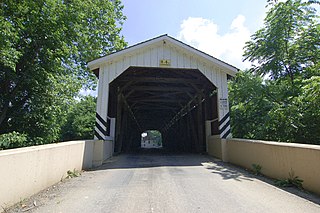
Martic Township is a township in southwestern Lancaster County, Pennsylvania, United States. At the 2020 census, the population was 5,237. Martic Township was organized in 1729. It borders Conestoga, Providence, Pequea and Drumore townships.

Madison Township is a township in Armstrong County, Pennsylvania, United States. The population was 826 at the 2020 census, an increase over the figure of 820 tabulated in 2010.

Reed Township is a township in Dauphin County, Pennsylvania, United States. The population was 229 at the 2020 census, a decline from 239 in 2010.

Upland is a borough in Delaware County, Pennsylvania, United States. Upland is governed by an elected seven-member borough council. The population was 3,239 at the 2010 census, up from 2,974 at the 2000 census.
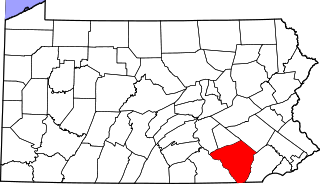
This is a list of the National Register of Historic Places listings in Lancaster County, Pennsylvania.

Pithole, or Pithole City, is a ghost town in Cornplanter Township, Venango County, Pennsylvania, United States, about 6 miles (9.7 km) from Oil Creek State Park and the Drake Well Museum, the site of the first commercial oil well in the United States. Pithole's sudden growth and equally rapid decline, as well as its status as a "proving ground" of sorts for the burgeoning petroleum industry, made it one of the most famous of oil boomtowns.
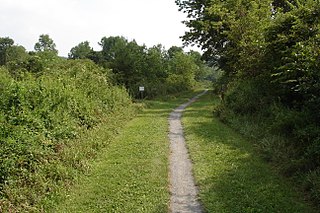
Jacobsburg Environmental Education Center is a 1,168-acre (473 ha) Pennsylvania state park near Wind Gap, in Bushkill Township, Northampton County in Pennsylvania. The Jacobsburg National Historic District is almost entirely surrounded by the park. Jacobsburg Environmental Education Center is just off the Belfast exit of Pennsylvania Route 33.

The Wiconisco Canal was a 19th century transportation waterway, about 12 miles (19 km) long, in Dauphin County in the U.S. state of Pennsylvania. Running along the east bank of the Susquehanna River between Millersburg and Duncan's Island at the mouth of the Juniata River, the canal overcame about 42 feet (13 m) of vertical lift through the use of 7 locks.

The King Iron Bridge & Manufacturing Company was a late-19th-century bridge building company located in Cleveland, Ohio. It was founded by Zenas King (1818–1892) in 1858 and subsequently managed by his sons, James A. King and Harry W. King and then his grandson, Norman C. King, until the mid-1920s. Many of the bridges built by the company were used during America's expansion west in the late 19th century and early 20th century, and some of these bridges are still standing today.

This is a list of the National Register of Historic Places listings in Erie County, Pennsylvania.

This is a list of the National Register of Historic Places listings in Columbia County, Pennsylvania.

This is a list of the National Register of Historic Places listings in McKean County, Pennsylvania.

This is a list of the National Register of Historic Places listings in Northumberland County, Pennsylvania.
Damariscove is an uninhabited island that is part of Boothbay Harbor in Lincoln County, Maine, United States, approximately 5 nautical miles (9.3 km) off the coast at the mouth of the Damariscotta River. The long, narrow island is approximately 2 miles (3.2 km) long and 1,500 feet (460 m) at its widest point. The island has served in the past as a fishing settlement and a United States Coast Guard life saving station.
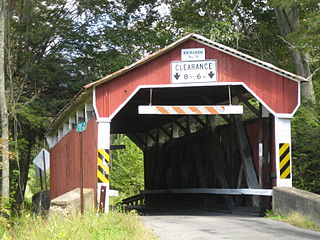
The Richards Covered Bridge is a historic wooden covered bridge located at Cleveland Township in Columbia County, Pennsylvania and Ralpho Township in Northumberland County, Pennsylvania. It is a 64-foot-long (20 m), multiple King post and Queen Post Truss bridge, constructed in 1852. It crosses South Branch Roaring Creek and is one of 28 historic covered bridges in Columbia and Montour Counties. It was listed on the National Register of Historic Places in 1979.
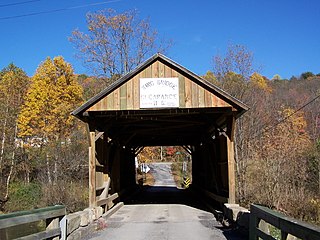
King Covered Bridge is a historic wooden covered bridge located at Wayne Township in Greene County, Pennsylvania. It is a 46.5-foot-long (14.2 m), Queenpost truss bridge with a tin covered gable roof. It crosses the Hoover Run. As of October 1978, it was one of nine historic covered bridges in Greene County.

The Frey-Haverstick Site (36LA6) is a prehistoric and historic archaeological site located in Manor Township, Lancaster County, Pennsylvania. The site was excavated in 1931, 1971, and 1975 by the Pennsylvania Historical and Museum Commission. Artifacts on the site were discovered as early as 1873, and included a helmet of Swedish origin dated to the reign of King Gustavus II Adolphus (1611–1632). The site features a Susquehannock cemetery, a Middle Woodland habitation site, and a Shenks Ferry village. Various artifact date activities on the site between 3500 BC. and 1650 AD.

The Kirks Mills Historic District is a national historic district that is located in Little Britain Township, Lancaster County, Pennsylvania, United States.
The Duncan Grant Ranch was established by Scottish immigrant Duncan Grant in Platte County, Wyoming in the 1870s. It is a representative example of an immigrant homestead ranch of the late 1800s.



















